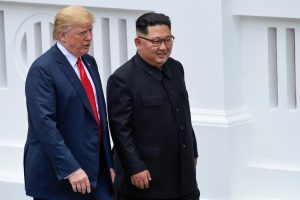
By Matt Spetalnick
WASHINGTON (Reuters) – The missile engine test site that President Donald Trump said North Korean leader Kim Jong Un had committed to destroy is a major facility in the western part of the country that has been used for testing engines for long-range missiles, according to a U.S. official.
Trump told reporters after their June 12 summit that Kim had pledged to dismantle one of his missile installations, which would be North Korea’s most concrete concession at the landmark meeting in Singapore.
However, the president at the time did not name the site.
A U.S. official identified it on Wednesday as the Sohae Satellite Launching Ground, saying North Korea “has used this site to test liquid-propellant engines for its long-range ballistic missiles.”
Pyongyang has said its missiles can reach the United States.
“Chairman Kim promised that North Korea would destroy a missile engine test stand soon,” the official told Reuters, speaking on condition of anonymity.
There was no immediate word on the exact timetable, and North Korea has not publicly confirmed that Kim made such a commitment.
CBS News was the first to identify the site, which is the newest of North Korea’s known major missile testing facilities.
Although Trump has hailed the Singapore summit as a success, skeptics have questioned whether he achieved anything, given that Pyongyang, which has rejected unilateral nuclear disarmament, appeared to make no new tangible commitments in a joint written declaration.
The U.S.-based North Korea monitoring group 38 North said in an analysis at the end of last week there had been no sign of any activity toward dismantling Sohae or any other missile test site.
The U.S. official said: “The United States will continue to monitor this site closely as we move forward in our negotiations.”
LITTLE-KNOWN SITE
What little is known about the Sohae site, located in Tongchang-ri, has been pieced together from analysts’ assessments and the North Korean state news agency KCNA.
It was reported to have been established in 2008 and has research facilities nearby for missile development as well as a tower that can support ballistic missiles. The site is mainly used to test large Paektusan engines built for long-range missiles such as the Hwasong-15.
North Korea has spent considerable effort and resources to develop the site as a “civilian space program” facility, denying that it has a military application, said Jenny Town, a research analyst at the 38 North.
“Presumably, if North Korea does destroy the Sohae facility, they are also signaling that they are willing to stop satellite/rocket launches this time around as well, a point that has derailed negotiations in the past and is a significant new development,” she said.
North Korea has other missile testing facilities but the shutdown, if it happens, would be significant, analysts said.
“The missile testing is not just done in Tongchang-ri so it does not necessarily mean all ICBMs (intercontinental ballistic missiles) will be disabled. But the most well-known one is this, so there is a great symbolic meaning if this is shut down,” said Moon Hong-sik, a research fellow at the Institute for National Security Strategy in South Korea.
North Korea announced ahead of the Singapore summit the suspension of its ICBM testing and also closed its nuclear bomb test site. U.S. officials, however, have cautioned that such actions are reversible.
Asked on Wednesday whether North Korea has done anything toward denuclearization since the summit, U.S. Defense Secretary Jim Mattis told reporters: “No, I’m not aware of that. I mean, obviously, it’s the very front end of a process. The detailed negotiations have not begun. I wouldn’t expect that at this point.”
Yang Uk, senior research fellow at the Korea Defence and Security Forum, agreed that a shutdown of the Sohae testing site would be a symbolic gesture rather than a move to technically disable its missile capabilities.
“Sohae has technically been used as an ‘engine’ testing site. North Korea has already finished developing (the) Baekdu Engine, so there would be no problem running ICBM missile programs even if they close down the Sohae site,” Yang said.
The move will only be significant if North Korea takes more than cosmetic steps to fully shutter the site, not just the test stand, said Melissa Hanham, a senior research associate at the James martin Center for Nonproliferation Studies.
“It’s only a good deal if they dismantle all the facilities at Sohae and re-employ the scientists in something civilian,” she said.
(Reporting by Matt Spetalnick; Additional reporting by Idrees Ali in WASHINGTON and Christine Kim, Josh Smith, and Jeongmin Kim in SEOUL; Editing by Lisa Schumaker and Darren Schuettler)









